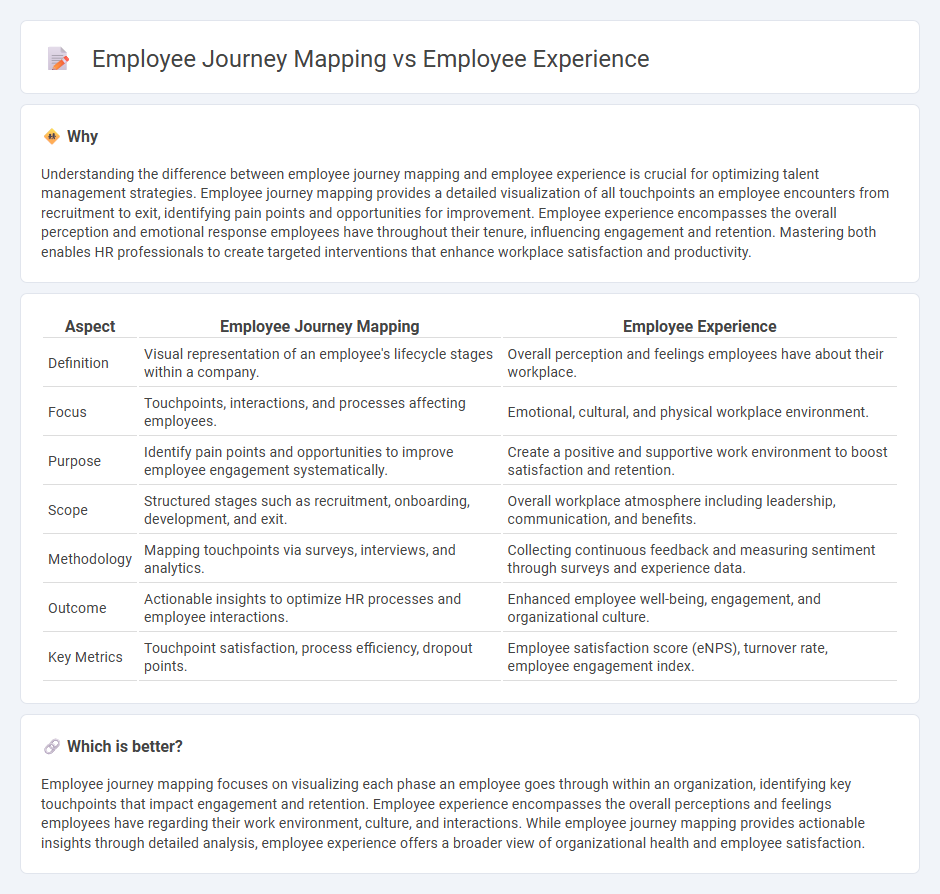
Employee journey mapping visually outlines each stage an employee passes through within an organization, highlighting key interactions and touchpoints from recruitment to offboarding. Employee experience encompasses the overall perceptions, emotions, and outcomes shaped by these interactions, directly impacting engagement, retention, and productivity. Explore further to understand how aligning journey mapping with experience design enhances workforce satisfaction and organizational success.
Why it is important
Understanding the difference between employee journey mapping and employee experience is crucial for optimizing talent management strategies. Employee journey mapping provides a detailed visualization of all touchpoints an employee encounters from recruitment to exit, identifying pain points and opportunities for improvement. Employee experience encompasses the overall perception and emotional response employees have throughout their tenure, influencing engagement and retention. Mastering both enables HR professionals to create targeted interventions that enhance workplace satisfaction and productivity.
Comparison Table
| Aspect | Employee Journey Mapping | Employee Experience |
|---|---|---|
| Definition | Visual representation of an employee's lifecycle stages within a company. | Overall perception and feelings employees have about their workplace. |
| Focus | Touchpoints, interactions, and processes affecting employees. | Emotional, cultural, and physical workplace environment. |
| Purpose | Identify pain points and opportunities to improve employee engagement systematically. | Create a positive and supportive work environment to boost satisfaction and retention. |
| Scope | Structured stages such as recruitment, onboarding, development, and exit. | Overall workplace atmosphere including leadership, communication, and benefits. |
| Methodology | Mapping touchpoints via surveys, interviews, and analytics. | Collecting continuous feedback and measuring sentiment through surveys and experience data. |
| Outcome | Actionable insights to optimize HR processes and employee interactions. | Enhanced employee well-being, engagement, and organizational culture. |
| Key Metrics | Touchpoint satisfaction, process efficiency, dropout points. | Employee satisfaction score (eNPS), turnover rate, employee engagement index. |
Which is better?
Employee journey mapping focuses on visualizing each phase an employee goes through within an organization, identifying key touchpoints that impact engagement and retention. Employee experience encompasses the overall perceptions and feelings employees have regarding their work environment, culture, and interactions. While employee journey mapping provides actionable insights through detailed analysis, employee experience offers a broader view of organizational health and employee satisfaction.
Connection
Employee journey mapping visualizes key interactions between employees and the organization, highlighting touchpoints that shape overall employee experience. By identifying pain points and moments of engagement, organizations can tailor strategies to enhance satisfaction, retention, and productivity. This connection drives a more personalized and effective approach to managing talent and improving workplace culture.
Key Terms
Engagement
Employee experience encompasses the overall perceptions and feelings employees have throughout their tenure, directly impacting engagement levels and workplace satisfaction. Employee journey mapping breaks down specific touchpoints and interactions employees encounter, enabling organizations to identify moments that boost or hinder engagement. Explore how aligning these strategies enhances retention and productivity in your company.
Touchpoints
Employee experience encompasses the overall perception and emotions an employee has throughout their tenure, while employee journey mapping identifies specific touchpoints--key interactions between the employee and the organization--to enhance engagement and satisfaction. Critical touchpoints include onboarding, performance reviews, and offboarding, which directly impact morale and productivity. Discover how optimizing these touchpoints can transform employee experience and drive organizational success.
Feedback
Employee experience encompasses the overall satisfaction and engagement an employee feels throughout their time with a company, while employee journey mapping specifically visualizes key touchpoints where feedback is gathered to improve these moments. Effective feedback mechanisms within employee journey mapping highlight pain points and opportunities for growth, directly influencing strategies to enhance the employee experience. Explore how integrating continuous feedback into journey mapping can transform workplace culture and increase retention.
Source and External Links
What Is the Employee Experience? - The employee experience encompasses every interaction an employee has with a company, including onboarding, performance management, and workplace environment, directly affecting productivity and company profitability.
What is Employee Experience? | Definition from TechTarget - Employee experience is a worker's perception of their employer through the entire employment lifecycle, influencing engagement, retention, and business outcomes.
How to Improve the Employee Experience - Improving employee experience involves understanding the employee journey and focusing on work-life balance, fair hiring practices, and aligning roles with culture to enhance retention and engagement.
 dowidth.com
dowidth.com